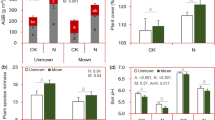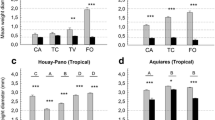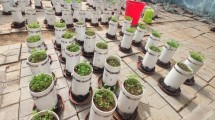Abstract
Background and aims
We evaluated the influence of plant species and life forms on soil aggregate distribution among size-classes, total macroaggregate mass and aggregate mean weight diameter (MWD), and examined how specific root traits were related to these aggregation variables.
Methods
We analyzed the soil attached to the roots (i.e., rhizospheric soil) under 13 Mediterranean species grown in monocultures in a common garden experiment for four years, and compared it to a bare soil. The mass distribution of aggregates in six size-classes and aggregate MWD were calculated, both on a rhizospheric soil and root biomass basis.
Results
Compared to bare soil, macroaggregate mass increased by an average of 13% in the presence of plants, with a strong effect of species and life forms (both P < 0.0001); some species such as Sanguisorba minor showing increases of up to ~40%. Although the soil under graminoids had a greater macroaggregate mass, their MWD was lower than under non-woody dicots. Large (2000–1000 μm) and intermediate (1000–500 μm) macroaggregate mass increased with root mass and length density and decreased with root lignin concentration, while very large macroaggregate (6000–2000 μm) mass and the MWD increased with root soluble compound concentration.
Conclusions
Species and life forms differently influenced the distribution of macroaggregates among size-classes and aggregate MWD. Easily-decomposable roots with traits related to resource acquisition (i.e., high fine root length, high water-soluble compound concentration) are more favorable for the development of water-stable macroaggregates than roots traits related to resource conservation (high lignin concentration, thick roots).



Similar content being viewed by others
References
Abiven S, Menasseri S, Angers DA, Leterme P (2008) A model to predict soil aggregate stability dynamics following organic residue incorporation under field conditions. Soil Sci Soc Am J 72:119
Abiven S, Menasseri S, Chenu C (2009) The effects of organic inputs over time on soil aggregate stability – a literature analysis. Soil Biol Biochem 41:1–12
Amundson R, Berhe AA, Hopmans JW, Olson C, Sztein AE, Sparks DL (2015) Soil and human security in the 21st century. Science (80) 348:126071(1-6)
Angers DA (1992) Changes in soil aggregation and organic carbon under corn and alfalfa. Soil Sci Soc Am J 56:1244–1249
Angers D, Caron J (1998) Plant-induced changes in soil structure: processes and feedbacks. Biogeochemistry 42:55–72
Angers DA, Bullock MS, Mehuys GR (2007) Aggregate stability to water - chapter 62. In: Carter M, Gregorich E (eds) Soil sampling and methods of analysis, Second edition. CRC Press, Boca Ratton
Bardgett RD, Mommer L, De Vries FT (2014) Going underground : root traits as drivers of ecosystem processes. Trends Ecol Evol 29:692–699
Blankinship JC, Fonte SJ, Six J, Schimel JP (2016) Plant versus microbial controls on soil aggregate stability in a seasonally dry ecosystem. Geoderma 272:39–50
Bronick C, Lal R (2005) Soil structure and management: a review. Geoderma 124:3–22
Cotrufo MF, Wallenstein MD, Boot CM, Denef K, Paul E (2013) The microbial efficiency-matrix stabilization (MEMS) framework integrates plant litter decomposition with soil organic matter stabilization: do labile plant inputs form stable soil organic matter? Glob Chang Biol 19:988–995
Cotrufo M, Soong J, Horton A, Campbell E, Haddix M, Wall D, Parton W (2015) Formation of soil organic matter via biochemical and physical pathways of litter mass loss. Nat Geosci 8:776–779
Czarnes S, Dexter A, Bartoli F (2000) Wetting and drying cycles in the maize rhizosphere under controlled conditions. Mechanics of the root-adhering soil. Plant Soil 221:253–271
Daget P (1977) Le bioclimat Méditerranéen: caractères généraux, modes de caractérisation. Vegetation 34:1-20
De Deyn GB, Cornelissen JHC, Bardgett RD (2008) Plant functional traits and soil carbon sequestration in contrasting biomes. Ecol Lett 11:516–531
Degens B (1997) Macroaggregation of soils by biological bonding and binding mechanisms and the factors affecting these: a review. Aust J Soil Res 35:431–459
Dutartre P, Bartoli F, Andreux F, Portal JM, Ange A (1993) Influence of content and nature of organic matter on the structure of some sandy soils from West Africa. Geoderma 56:459–478
Erktan A, Cécillon L, Graf F, Roumet C (2016) Increase in soil aggregate stability along a Mediterranean successional gradient in severely eroded gully bed ecosystems: combined effects of soil, root traits and plant community characteristics. Plant Soil 398:121–137
Fernández-Ugalde O, Virto I, Barré P, Gartzia-Bengoetxea N, Enrique A, Imaz MJ, Bescansa P (2011) Effect of carbonates on the hierarchical model of aggregation in calcareous semi-arid Mediterranean soil. Geoderma 166:214–216
Fernández-Ugalde O, Virto I, Barré P, Apesteguía M, Enrique A, Imaz MJ, Bescansa P (2014) Mechanisms of macroaggregate stabilisation by carbonates: implications for organic matter protection in semi-arid calcareous soils. Soil Res 52:180–192
Gould IJ, Quinton JN, Weigelt A, De Deyn GB, Bardgett RD, Seabloom E (2016) Plant diversity and root traits benefit physical properties key to soil function in grasslands. Ecol Lett 19:1140–1149
Harley JL, Harley EL (1987) A check-list of mycorrhiza in the British flora. New Phytol 105:1–102
Harris R, Chesters G, Allen N (1966) Dynamics of soil aggregation. Adv Agron 18:107–169
Jastrow JD (1996) Soil aggregate formation and the accrural of particulate and minerals-associated organic matter. Soil Biol Biochem 28:665–676
Jastrow J, Miller R, Lussenhop J (1998) Contributions of interacting biological mechanisms to soil aggregate stabilization in restored prairie. Soil Biol Biochem 30:905–916
Keesstra S, Pereira P, Novara A, Brevik EC, Azorin-Molina C, Parras-Alcántara L, Jordán A, Cerdà A (2016) Effects of soil management techniques on soil water erosion in apricot orchards. Sci Total Environ 551–552:357–366
Le Bissonnais Y (2016) Aggregate stability and assessment of soil crustability and erodibility : I. Theory and methodology. Eur J Soil Sci 67:11–21
Le Bissonnais Y, Blavet D, De Noni G, Laurent J-Y, Asseline J, Chenu C (2007) Erodibility of Mediterranean vineyard soils: relevant aggregate stability methods and significant soil variables. Eur J Soil Sci 58:188–195
Martin T (1942) The effect of composts and compost materials upon aggregation of the silt and clay particles of Collington sandy loam. Soil Sci Soc Am Proc 7:218–222
Martins MDR, Angers DA (2015) Different plant types for different soil ecosystem services. Geoderma 237–238:266–269
Martins MDR, Angers DA, Corá JE (2012) Carbohydrate composition and water-stable aggregation of an oxisol as affected by crop sequence under no-til. Soil Sci Soc Am J 76:475–484
Materechera SA, Dexter AR, Alston AM (1992) Formation of aggregates by plant roots in homogenised soils. Plant Soil 142:69–79
Materechera SA, Kirby JM, Alston AM, Dexter AR (1994) Modification of soil aggregation by watering regime and roots growing through beds of large aggregates. Plant Soil 160:57–66
McCormack ML, Guo D, Iversen CM, Chen W, Eissenstat DM, Fernandez CW, Li L, Ma C, Ma Z, Poorter H et al (2017) Building a better foundation: improving root-trait measurements to understand and model plant and ecosystem processes. New Phytol 215:27–37
Miller R, Jastrow J (1990) Hierarchy of root and mycorrhizal fungal interactions with soil aggregation. Soil Biol Biochem 22:579–584
Miller R, Jastrow J (1992) The application of VA mycorrhizae to ecosystem restoration and reclamation. In: Allen M (ed) Mycorrhizal functioning - an integrative plant-fungal process. Chapman & Hall, NY, pp 438–467
Nimmo JR, Perkins KS (2002) Aggregate stability and size distribution. In: Dane JH, Topp GC (eds) Methods of soil analysis, part 4-physical methods. Soil Science Society of America, Madison, pp 317–328
Oades J (1984) Soil organic matter and structural stability : mechanisms and implications for management. Plant Soil 76:319–337
Pérès G, Cluzeau D, Menasseri S, Soussana J, Bessler H, Engels C, Habekost M, Gleixner G, Weigelt A, Weisser W et al (2013) Mechanisms linking plant community properties to soil aggregate stability in an experimental grassland plant diversity gradient. Plant Soil 373:285–299
Phillips RP, Fahey TJ, Ecology S, May N, Phillips RP, Fahey TJ (2006) Tree species and mycorrhizal associations influence the magnitude of rhizosphere effects. Ecology 87:1302–1313
Poirier V, Angers DA, Whalen JK (2014) Formation of millimetric-scale aggregates and associated retention of 13C–15N-labelled residues are greater in subsoil than topsoil. Soil Biol Biochem 75:45–53
Puget P, Chenu C, Balesdent J (1995) Total and young organic matter distributions in aggregates of silty cultivated soils. Eur J Soil Sci 46:449–459
Rillig M, Mummey D (2006) Mycorrhizas and soil structure. New Phytol 171:41–53
Rillig MC, Aguilar-Trigueros CA, Bergmann J, Verbruggen E, Veresoglou SD, Lehmann A (2015) Plant root and mycorrhizal fungal traits for understanding soil aggregation. New Phytol 205:1385–1388
Roumet C, Birouste M, Picon-Cochard C, Ghestem M, Osman N, Vrignon-Brena S, Cao K-F, Stokes A (2016) Root structure-function relationahips in 74 species: evidence of a root economics spectrum related to carbon economy. New Phytol 210:815–826
SAS Institute (2002) SAS/STAT for Windos version 9.2. Cary, NC
Six J, Elliott E, Paustian K (2000) Soil macroaggregate turnover and microaggregate formation: a mechanism for C sequestration under no-tillage agriculture. Soil Biol Biochem 32:2099–2103
Six J, Frey SD, Thiet RK, Batten KM (2006) Bacterial and fungal contributions to carbon sequestration in agroecosystems. Soil Sci Soc Am J 70:555
Söderberg KH, Probanza A, Jumpponen A, Bååth E (2004) The microbial community in the rhizosphere determined by community-level physiological profiles (CLPP) and direct soil- and cfu-PLFA techniques. Appl Soil Ecol 25:135–145
Systat Software Inc. (2014) SigmaPlot for Windows version 13.0. Point Richmond, CA
Tisdall J, Oades J (1982) Organic matter and water-stable aggregates in soils. J Soil Sci 33:141–163
Turpault M-P, Righi D, Utérano C (2008) Clay minerals: precise markers of the spatial and temporal variability of the biogeochemical soil environment. Geoderma 147:108–115
Van Soest P (1963) Use of detergents in the analysis of fibrous feeds. II. A rapid method for the determination of fiber and lignin. J Assoc Off Anal Chem 46:829–835
Verspagen JMH, Visser PM, Huisman J (2006) Aggregation with clay causes sedimentation of the buoyant cyanobacteria Microcystis spp. Aquat Microb Ecol 44:165–174
Violle C, Navas M-L, Vile D, Kazakou E, Fortunel C, Hummel I, Garnier E (2007) Let the concept of trait be functional! Oikos 116:882–892
Wang B, Qiu YL (2006) Phylogenetic distribution and evolution of mycorrhizas in land plants. Mycorrhiza 16:299–363
Zheng W, Morris EK, Rillig MC (2014) Ectomycorrhizal fungi in association with Pinus Sylvestris seedlings promote soil aggregation and soil water repellency. Soil Biol Biochem 78:326–331
Acknowledgments
The authors would like to thank the Fonds de recherche du Québec – Nature et technologies for financial support through a postdoctoral fellowship awarded to Vincent Poirier, the Natural Sciences and Engineering Research Council of Canada (NSERC) for a Discovery grant awarded to Alison D. Munson., the Groupement de Recherche International “Dynamique de la biodiversité et traits d’histoire de vie” (GDRI-n°BFC 44745, CNRS, France) and the Agence Nationale de la Recherche (project O2LA, ANR-09-STRA-09) for financial support through the experiment. Thanks are due to the staff of the Plateforme d’Analyses Chimiques en Ecologie (PACE) and of the CEFE experimental field (technical facilities of the Labex Centre Méditerranean de l’Environnement et de la Biodiversité, CEMEB). We are also thankful to Étienne Laliberté, Claire Chenu and Grégoire Freschet for helpful comments and discussions.
Author information
Authors and Affiliations
Corresponding author
Additional information
Responsible Editor: Michael Luke McCormack
Electronic supplementary material
ESM 1
(DOCX 28 kb)
Table S1
(DOCX 37 kb)
Table S2
(DOCX 32 kb)
Fig. S1.
Mass distribution of rhizospheric soil among aggregate size classes expressed per unit soil mass for bare soil, 13 species and life forms. a) Very large macroaggregates (VLMsoil), b) Large macroaggregates (LMsoil), c) Intermediate macroaggregates (IMsoil), d) Small macroaggregates (SMsoil), e) Microaggregates (Misoil) and f) Fine fraction (Finesoil). See Table 1 for species abbreviations. * The mass distribution of aggregates in the bulk soil is given since no plants were present in the bare soil. (GIF 422 kb)
Fig. S2.
Mass distribution of rhizospheric soil among aggregate size classes expressed per unit belowground biomass to depth of 0-10 cm (BB) for bare soil, 13 species and life forms. a) Very large macroaggregates (VLMBB), b) Large macroaggregates (LMBB), c) Intermediate macroaggregates (IMBB), d) Small macroaggregates (SM BB), e) Microaggregates (MiBB) and f) Fine fraction (FineBB). See Table 1 for species abbreviations. (GIF 407 kb)
Rights and permissions
About this article
Cite this article
Poirier, V., Roumet, C., Angers, D.A. et al. Species and root traits impact macroaggregation in the rhizospheric soil of a Mediterranean common garden experiment. Plant Soil 424, 289–302 (2018). https://doi.org/10.1007/s11104-017-3407-6
Received:
Accepted:
Published:
Issue Date:
DOI: https://doi.org/10.1007/s11104-017-3407-6




